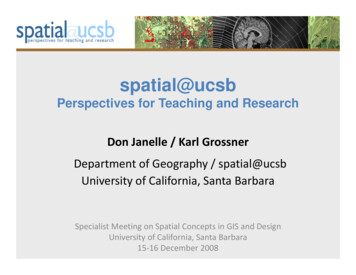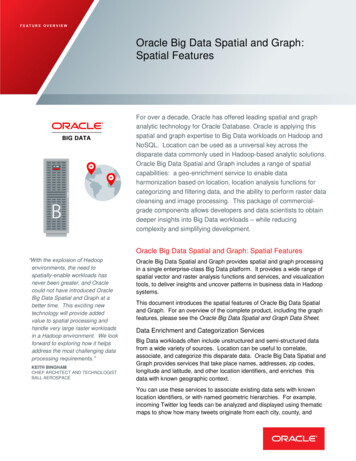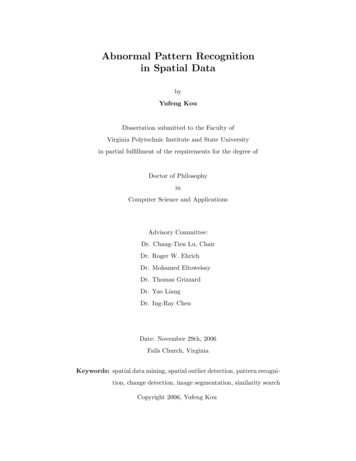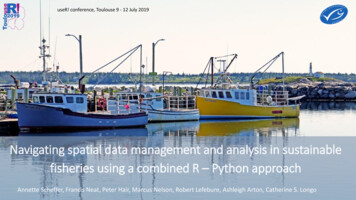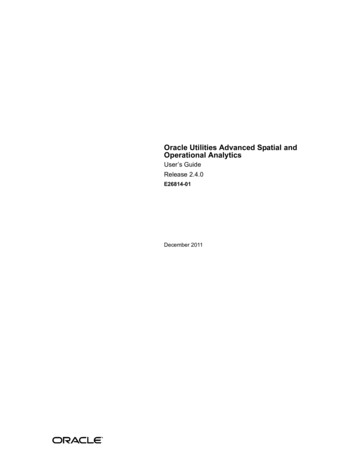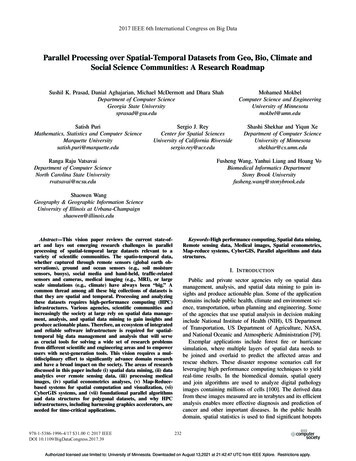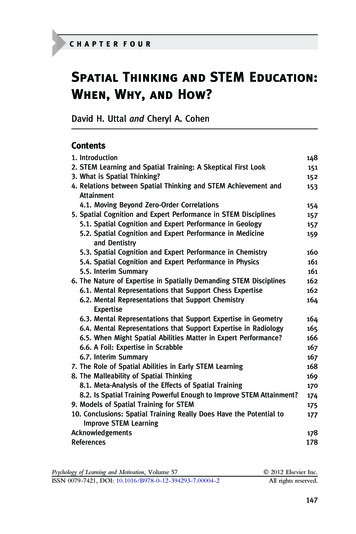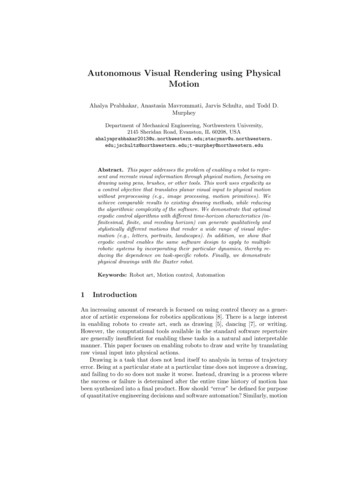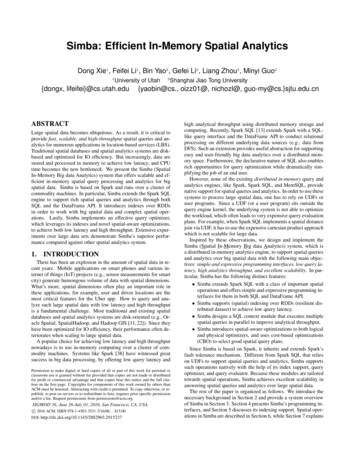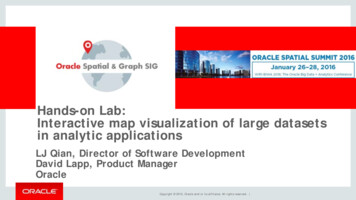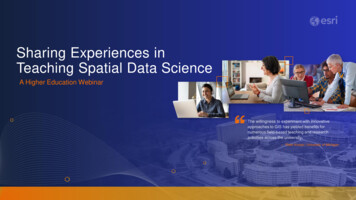
Transcription
Sharing Experiences inTeaching Spatial Data ScienceA Higher Education Webinar– Peter Knoop University of Michigan
PresentersDr. Trisalyn NelsonUC Santa BarbaraDr. Song GaoUniversity of Wisconsin MadisonDr. Ilya ZaslavskyUC San DiegoDr. Lauren BennettEsriCanserina Kurnia, M.L.AEsri
Spatial Data SciencePrograms: Opportunitiesand ChallengesTrisalyn NelsonDangermond Chair of tof Geography NameOffice/Department/Division
Spatial Data Science Programs BSc in Geomatics BSc in GIS (online and oncampus) Masters in GIS BS in Data Science spatial emphasisOffice/Department/Division Name BA in GIScience Spatial Studies Minor PhD in Geography:GIScience &Geoinformatics
Thoughts on Decisions and Challenges Audience and sizeTeaching programming/statisticsPrerequisites (equity implications)Student recruitmentOffice/Department/Division Name
Trisalyn@ucsb.eduOffice/Department/Division Name
Teaching Spatial Data ScienceDr. Song GaoGeospatial Data Science LabUniversity of Wisconsin – Madisonhttps://geods.geography.wisc.edu/
New Data Science Major and Spatial Data Science Curriculumhttps://datascience.wisc.edu/
New Data Science Major and Spatial Data Science Curriculumhttps://datascience.wisc.edu/
Two different groups of mindsetsGeography electedData Science electedImage Source: science-as-your-career-en
Final g573/
Learned from experiences Acknowledge differences in thinking, knowledge, and skills Engage with real-world problems/applications Students love code examples
4816
Thank you!
“Spatial DataScience andApplications”at UC San DiegoIlya ZaslavskyDirector, Spatial Information Systems LabSan Diego Supercomputer Center, UCSD
Teaching “spatial” to data scientists Massive enrollments in data science programs across the US: needcurriculum building on skills and knowledge from DSC courses DSC170 is an upper division elective for UCSD data science majors: Students have 2 years of Python and machine learning Coding requirements makes it difficult to attract students from other departments Practical project-based approach, with real data and problems from severaldomains Open-source and commercial spatial data libraries AI libraries; intenseon-line interactions outside lectures and discussions Direct interaction with ESRI developers – extremely helpful! A trove of notes and workarounds discovered by students – and sharedwith ESRI
DSC170 Course Recap: the basicsPrior KnowledgeCritical ThinkingNew ConceptsMapsHow to map data, andwhy some maps are badCartographyRulesPandasTypes of spatial data andhow they are differentGeoPandasWhy GDFs sometimesdon’t align on a map?ProjectionsWhy binary spatial predicatessometimes don’t work?Geometric issuesand uncertaintiesHow to describe dataquality?Spatial metadataHow to test and ensuredata integrity?Spatial datastructures
DSC170 Course Recap: feature analysisPrior lve,buffer, spatialjoin, )Critical ThinkingNew ConceptsOther libraries?Comprehensive? Better maps?ArcGIS API forPythonSome operations are the sameSpatially-enabled data frameand operations on SEDFSome operations are different –they are over “layers”Feature sets and layers, andoperations on layersHow to handle all the differentdata generated in GIS analysisAll data can be managed inAGOLHow to make decisions aboutwidth of buffers; joins, etc.Core purpose : integrating disparatedata from different sourcesNeed to understand trade-offsand make assumption explicit
DSC170 Course Recap: imageryPrior KnowledgeArcGIS API forPythonArcGIS vectoroperations(geocoding,extent,overlay)Critical ThinkingOther types of spatial data, andhow they are differentNew ConceptsImagery layersWhere to find and how tocompute imagery layers?AGOL, and embeddedraster functionsHow to combine rasters?Raster map algebraWhy (A B) (B A)in raster calculator?What are trade-offs incombining rastersServer infrastructure forbig raster dataRules of mapcombination
DSC170 Course Recap: towards machine learningPrior KnowledgeScikit LearnCritical ThinkingWhere to find data and howto prepare data for ML?New Conceptsgis.content.searchGeoenrichmentSpatial AnalysisRastersHow to improve ML modelaccuracy with spatial data?How to detect objects?How to define and explicitlyrepresent spatial relationships?How to include spatial data instatistical models?Geocoding, drive-timeand regular buffersArcgis.learn (SSD,random forest, etc.)Spatial weights, spatiallag variables, spatialautocorrelationRegression withrastersRegression withspatial weights
GIS forScience,Vol. 3Now inPrint!
Student feedbackDuring summer internship,I was stood out because ofthe speciality in spatialdata when we took over aproject which analyzesthe national powernetwork in China, and I wasthe only one in the teamwho had experience ingeopandas and arcgis
Spatial data science for COVID-19 analysis and modelingCOVID-19 Predictive Modeling DashboardDSC170 final student projects are publicly availableSpatially-explicit agent-based model of COVID-19 in schools
Are GIS analysts alreadydata scientists?Lauren Bennett, PhD
What does the GIS community do? We solve the world’s most complex spatial problems We apply a myriad of tools and approaches to tackle diverse problems We use the best available methods and technology We work across domains and industries
What is a data scientist?To me, data plus math and statistics onlygets you machine learning, which is great ifthat is what you are interested in, but not ifyou are doing data science. Science isabout discovery and building knowledge,which requires some motivating questionsabout the world and hypotheses that canbe brought to data and tested withstatistical methods.-Drew Conway
What is a data scientist?
What is a data scientist?Spatial Analysis,
The building blocks of spatial data scienceDataEngineeringVisualization& ExplorationSpatialAnalysisMachine Learning& AIBig DataAnalyticsModeling& ScriptingSharing& Collaboration
Advancing Spatial ScienceDataEngineeringVisualization& ExplorationSpatialAnalysisMachine Learning& AIBig DataAnalyticsModeling& ScriptingSharing& Collaboration
Advancing Spatial ScienceSpatial Approach
ArcGIS Advancing Spatial ScienceNetwork andRouting AnalysisAI, MachineLearning, DeepLearningVector andTabular Analysis,Spatial StatisticsRaster Analysis,Deep LearningReal-TimeAnalysisBig Vector andTabular DataAnalysisFocused on finding the right tools to solve your problem
Teaching and Learning Resources Spatial Data Science in Higher Education Spatial Analysis and Data Science Spatial Statistics Spatial Data Science MOOC A Guide to Spatial Data Science Coursesin Esri Academy More ?-Contact ckurnia@esri.comStart October 27, 2021
Thank you and please fill in the exit surveyTo connect, please reach out to Canserina at:ckurnia@esri.com
Programs: Opportunities and Challenges Trisalyn Nelson Dangermond Chair of Geography Trisalyn@ucsb.edu www.SparLab.org Department of Geography. Office/Department/Division Name Spatial Data Science Programs BSc in Geomatics BSc in GIS (online and on campus) Masters in GIS BS in Data Science - spatial emphasis BA in GIScience
